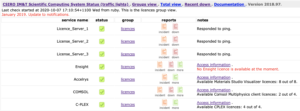CSIRO Computing History, Sidebar 4 – Applications Software
Sidebar 4 – Applications Software
Last updated: 8 Oct 2020.
Robert C. Bell
Applications Software
One of the critical problems in the use of high performance systems is the software to exploit them. It’s a chicken and egg situation: if you don’t have the right software, users can’t use the systems, but if you don’t have the users, you can’t justify the outlay on the software.
During the HPCCC era, Len Makin, head of User Services for CSIRO, tackled this problem, by negotiating with suppliers to have firstly the MSC software suite installed, and to allow usage by the use of tokens up to an agreed limit at any time. This was extended to other software, where HPSC purchased a network licence, and users could access this freely up to the limit of the number of concurrent users paid for. This proved extremely popular for items such as Matlab. A caution was issued that users who expected to use a piece of licensed software continually should expect to pay for it, but casual use was free.
From May 2006, a traffic light system was written and being run at the HPCCC to report on the status of systems, and this was extended in October 2007 to cover licensed software. At the top page, the number of available and in-use licences was reported for each software item, and users could click on links to reach the science software map which gave a summary of the capabilities of the software, to find out which systems ran the software, and how to access each item.
Here is a snapshot of part of the licensed software traffic lights in October 2020.
There were 22 items of software, and three licence servers.
Another major part of the software story was the open source movement. This allowed scientists access to the work of a community of developers around the world. Scripting and statistical languages such as perl, R and python were and are notable examples of such developments. Indeed, the whole open source/gnu/Linux community revolutionised the HPC software world. Whereas in the past operating systems were home-grown or proprietary (DAD, SCOPE, NOS), or based on versions of UNIX (UNICOS, SUPER-UX, IRIX), now almost all major systems run a Linux distribution: indeed, developments based on UNIX/Linux provide the operating system underneath almost all the world’s phones and other smart devices.

